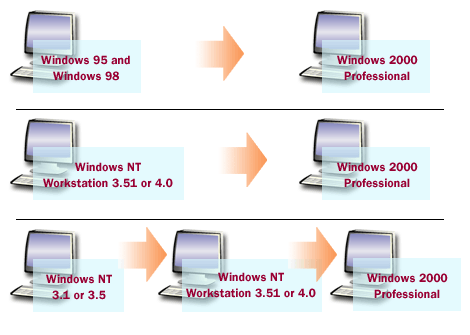| Lesson 2 | Identifying client upgrade paths |
| Objective | Identify client upgrade paths for Windows Professional |
Identifying Client Upgrade Paths for Windows Professional
The modern equivalent of "Windows Professional" depends on the specific features you valued in Windows Professional from the year 2000. Here are two possibilities:
To take advantage of the new features that the Windows Professional operating system offers, you can upgrade most Windows client operating systems directly to Windows 10. However, you must first ensure that the computer you will be upgrading meets the Windows 10 hardware requirements. This is especially important when you are upgrading a large number of client computers and want to avoid any surprises.
- Windows 11 Pro: This is the most likely equivalent if you primarily used Windows Professional for basic business functionality on a desktop machine. It offers more features than the Home edition, including domain joining, BitLocker encryption, and remote desktop capabilities.
- Windows 11 Pro for Workstations: This version is ideal if you used Windows Professional for workstations with demanding workloads. It builds upon Windows 11 Pro with features like increased memory support and faster file handling for professional use cases.
To take advantage of the new features that the Windows Professional operating system offers, you can upgrade most Windows client operating systems directly to Windows 10. However, you must first ensure that the computer you will be upgrading meets the Windows 10 hardware requirements. This is especially important when you are upgrading a large number of client computers and want to avoid any surprises.
Windows Professional Upgrade Paths from Windows 10 to Windows 11
Question: What are the Windows Professional Upgrade Paths from Windows 10 to Windows 11?
The Windows Professional upgrade paths from Windows 10 to Windows 11 are as follows:
The Windows Professional upgrade paths from Windows 10 to Windows 11 are as follows:
- Windows 10 Pro to Windows 11 Pro: This is the most straightforward upgrade path for Windows Professional users. If you have a Windows 10 Pro license, you can upgrade to Windows 11 Pro for free through Windows Update.
- Windows 10 Pro for Workstations to Windows 11 Pro for Workstations: If you have a Windows 10 Pro for Workstations license, you can upgrade to Windows 11 Pro for Workstations for free through Windows Update.
- Windows 10 Enterprise to Windows 11 Enterprise: If you have a Windows 10 Enterprise license, you can upgrade to Windows 11 Enterprise through the Volume Licensing Service Center (VLSC).
- Windows 10 Education to Windows 11 Education: If you have a Windows 10 Education license, you can upgrade to Windows 11 Education through the Volume Licensing Service Center (VLSC).
- Windows 10 Pro Education to Windows 11 Pro Education: If you have a Windows 10 Pro Education license, you can upgrade to Windows 11 Pro Education for free through Windows Update.
- Windows 10 IoT Enterprise to Windows 11 IoT Enterprise: If you have a Windows 10 IoT Enterprise license, you can upgrade to Windows 11 IoT Enterprise through the OEM channel.
The Hardware Compatibility List
The Windows 2000 hardware requirements will change periodically,
so you should make a habit of checking the most up-to-date list of approved Windows hardware before performing an upgrade.
This list is located on Microsoft's Windows Hardware Compatibility List Web site, which you can link to from the Resources page.
This list is located on Microsoft's Windows Hardware Compatibility List Web site, which you can link to from the Resources page.
Identifying client upgrade paths (Legacy)
Most client computers running earlier versions of Windows and Windows NT can be upgraded directly to Windows 2000.
However, computers running Windows NT 3.1 or 3.5 require an additional step.
Windows 2000 Professional upgrade paths (Legacy)

Legacy Upgrade Paths for Retired Operating Systems
| Windows version | Upgrade considerations |
| Windows2000 and Windows 98 | You can upgrade Windows2000 and Windows 98 directly to Windows 2000 Professional. When you upgrade, all your Windows 2000-compatible programs should remain intact and functional. |
| Windows NT Workstation 3.51 or 4.0 | Like Win9x computers, you should be able to upgrade both Windows NT 3.51 and Windows NT 4.0 machines without serious problems. However, you should confirm that your applications are compatible with Windows 2000 prior to the upgrade. |
| Windows NT 3.1 or 3.5 | Because of significant differences between the registries of the early versions of Windows NT and Windows 2000, there is no direct upgrade path from those versions. In order to upgrade older versions of NT, you must first upgrade them to a compatible upgrade version and then upgrade the upgraded version to Windows 2000. |
Upgrading Windows 2000
You cannot upgrade Windows 3.x directly to Windows 2000 Professional. You must first upgrade to Windows2000, Windows 98, or Windows NT 4.0, and then upgrade to Windows 2000 Professional. In the next lesson, you will learn how to upgrade Windows2000 or 98 clients to Windows 2000 Professional.
